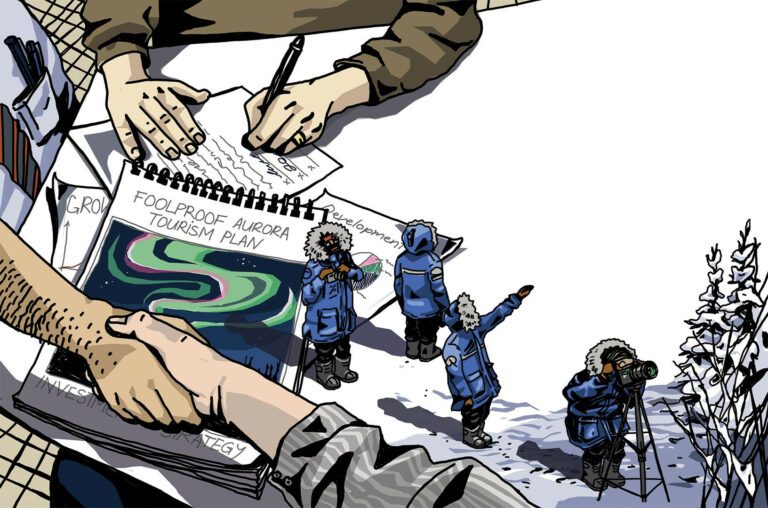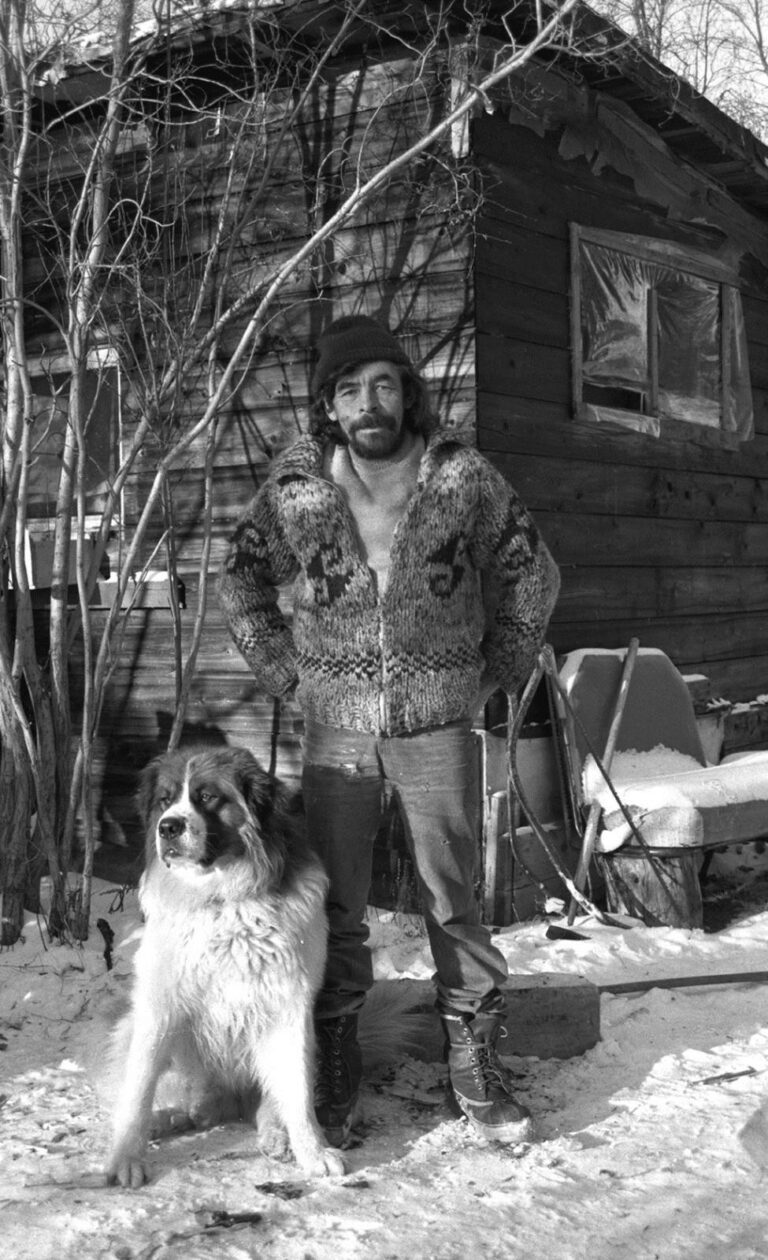Elaine Carr, an engineer with Williams Engineering for the past 14 years, has helped clients as large as the City of Yellowknife convert their facilities to biomass heating, cutting their costs and greenhouse gas emissions.
This story is sponsored by the NWT Biomass Energy Association | Looking for more info on the industry? Visit our new website and blog.

NWT Environment & Natural Resources Minister Michael Miltenberger has made it his mission to establish a biomass market and an industry in the territory by converting government buildings to pellet boilers and committing to Forest Management Agreements with First Nations hoping to source fuel for future pellet or wood chip operations.
The Government of the Northwest Territories first began to look seriously at biomass in 2007, when the growing need to manage costs and carbon emissions started to become too difficult to ignore. Rather than keep moving forward with piecemeal investments in clean energy, the government decided to come up with a territorial biomass strategy that would set out objectives for the future.
“For me, the plan was two steps: build the market and then once you do that, build an industry,” said Environment and Natural Resources Minister Michael Miltenberger, whose department led the work on the strategy. “We’ve spent the last eight years building the market. We’ve encouraged people to get into it, but as a government, we’ve made a very significant investment in converting our own buildings.”
Installers and suppliers in almost every community credit the GNWT with helping to make the advent of wood pellets viable in the North, despite a lack of local manufacturing. Twenty-two government-owned facilities, including schools, health centres, correctional facilities and the like, now run on biomass in the territory in nine communities. In the past year alone, the GNWT has installed nine boilers, including the largest ever single wood pellet boiler ever installed at 1,250 kW at the new Hay River Health Centre.
“Once these nine new wood pellet boiler systems are fully operational, it is expected that they will burn approximately 2,000 tonnes of wood pellets annually,” said Tom Beaulieu, Minister of Public Works and Services, the department which now oversees all of the government’s biomass installations. “Using this renewable heat source displaces the need of almost 1 million litres of heating oil a year for an equivalent annual reduction of GHGs of 2,600 tonnes.”
And as retrofits and new buildings work their way into capital spending plans, biomass is increasingly looked to as an ideal source of energy for Northern communities.
“Every new building is reviewed to include, if it’s applicable, biomass,” Miltenberger said. “On a cabinet basis, we lead the country in investment in biomass.”
The savings the GNWT has generated by using biomass instead of heating oil and propane – currently estimated at around $2 million – are then re-invested into a revolving fund used to help finance other biomass projects, like the recent installations done at airports in Norman Wells and Yellowknife, and the installation that provides heat to a complex of buildings including the new Yellowknife Office Building, the Arthur Laing Building and the Stuart M. Hodgson Building.
Not only were local private companies hired to do those installations, but the government demand for pellets has made bulk delivery possible in communities across the NWT where transportation and distribution may not have been previously feasible. That has meant residents, businesses, and property owners have been able to make the conversion and save money, while being able to count on a secure supply, and entrepreneurs can profit off of the sector.
Now, the Northwest Territories is at the leading edge of the biomass industry in Canada, and with further investments from government, growing private sector demand and an increased base of homeowners looking to cut heating costs, that lead is only bound to grow.
“The NWT is a real leader in biomass in Canada – I firmly believe that,” said Andy Taylor, whose company Taylor & Co. in Hay River installs biomass systems and supplies pellets across the South Slave region. “A lot of people look to us. People phone us to ask us questions and to talk about cost savings, and I think that tells you something – people are looking to us for answers.”
A change in mindset
Beyond technological advancements like more efficient boilers that can handle Northern winters, engineer Elaine Carr said it’s mostly been a shift in thinking that has led to an eruption of biomass in the NWT.
Her firm, Williams Engineering, helped the City of Yellowknife do the community energy plan in 2005 that would ultimately lead to the city converting its buildings over to pellets – when there was very little interest in biomass outside of small, private pellet stoves – and has since helped install dozens of projects throughout Yellowknife, at apartment complexes and municipal facilities, as well as installations in Norman Wells, Fort Simpson and Behchoko.
That change in mindset, Carr said, was thanks to ambitious pioneers who showed the territory that it could be done.

The Williams Engineering designed wood pellet boiler system supplies heat to the Yamouri Inn and Ramparts Store in Norman Wells.
“It really required someone to take that first step and prove the economics, because the economics were all theoretical until someone actually did it,” she said.
After the initial “leap of faith,” she said it took a couple of years as people worked to raise the capital to install boilers, and then learn how to maintain and operate somewhat unfamiliar technology.
“I think nobody wants to be the first, taking all the risks,” Carr said. “But as soon as someone else is taking all those risks and showing that it is actually as beneficial as they say, they are saving a lot of money, then it just had a cascade effect.”
That said, Carr acknowledged that certain technologies have made biomass more accessible and easier to use for consumers, which has helped the sector grow.
“The technology of having bulk delivery has been a huge step forward,” she said. “They’ve come a long way, and that really facilitates people’s use of the technology.”
Taylor agreed, adding that improved technologies over the years have made even the more expensive boilers economically feasible, just because of the high efficiency at which they burn fuel.
“Back in the mid-’80s and early ‘90s, people were using stoves back then. Now with the new technologies, manufacturers have taken it to a new level, they’re getting so much efficiency out of the pellets,” he said. “Now we’ve got way better stoves and boilers that save all kinds of money and won’t break down and that you don’t have to maintain a lot, and there’s new standards that protect the consumer.”
Securing a local supply
Though companies as far north as Inuvik and in places without permanent roads have been able make biomass economically feasible even while shipping in pellets from the south, most identify the transportation and distribution piece as being the most costly and logistically challenging for property owners, businesses and communities.
“Transportation and distribution are the major hurdles to overcome,” Carr said. “The communities where they have someone who’s invested in bulk storage of wood pellets are the ones where that makes it easier for the building owners to get into that, and to know that they have security of supply, because the last thing you want is your boiler not to have any fuel in the winter. It’s a lot easier on the road system; without the road system, it’s definitely more challenging.”

Currently, pellet suppliers in the NWT import pellets from mills in northern Alberta and B.C., but many feel they would be better served by a local mill, currently under consideration for the Enterprise area.
Furthermore, a limited supply of pellets also challenges suppliers in the NWT with being able to meet and maintain their yearly quota. Mills require pellet-buyers to commit to a set purchase amount at least a year ahead, and suppliers are competing to lock in a supply for years down the road.
Currently, Canada exports around 90 per cent of its pellets, leaving just 10 per cent to be split among a growing industry that is now seeing buy-in from the oil industry.
“With the oil field coming on board, they’re sometimes buying up the whole mill production,” Taylor said. “The GNWT needs to see that…and federally-wise, Canada should take care of their own before shipping out.”
That’s why innovators in the NWT are looking to create their own sustainable source of ready-to-burn biomass. For some communities, it’s as simple as cordwood, but for large scale district heating projects, businesses and community governments throughout the territory are eyeing up wood chips as a viable and efficient fuel.
Though manufacturing chips from green wood can be a time and labour intensive process, Mother Nature smoked the territory with an abundance of wildfires last summer, leaving some 3.5 million hectares of boreal forest burned and dry. Though such fires were costly and at times dangerous for Northerners, the opportunity that’s arisen through an abundance of ready-to-burn fuels could drop the costs of creating wood chips, thereby lowering operating costs and creating employment in the process.
“That wood is waiting to be cut down,” said Ken Miller, whose company J&R Mechanical has been involved in the installation of boilers in numerous apartment complexes and government buildings in Yellowknife, along with several district heating systems in Behchoko. “It has only one purpose now, and that’s to be harvested.”

A boiler installation by J&R Mechanical in Yellowknife services the Yellowknife airport.
Miltenberger said the GNWT is working on a policy for black wood to ensure “as much gets harvested as possible” by both commercial and residential users, regardless of what type of biomass product they are burning. He also hopes to tie fire-smarting efforts – whereby trees are cut around the perimeter of communities to protect them from forest fires – to biomass.
“If it’s a managed, thinned, selective harvest, we could have a sustainable energy source close to the community and a community that’s fire-smarted,” he said.
Even with an abundance of burned forest prime for chipping, the GNWT is also throwing its support behind a potential pellet mill in the territory, near Enterprise. If developed, the mill would support local harvesting in surrounding communities where First Nations have negotiated Forest Management Agreements with the government, ensuring a sustainable logging practice that creates jobs and supplies heat for the North – most notably for the GNWT, which has promised to buy the product.
While having local pellets would certainly be of benefit to suppliers in the NWT, Carr hopes those pellets can also get into the smaller communities currently supplied fuel by the GNWT.
“Every small community that is not economic for a gas station company to come in has a government-funded petroleum storage facility that stores and distributes a year’s worth of fuel,” she said. “So if you had that kind of thing for wood pellets, that would be fantastic. Then of course you don’t have any associated fuel spills or fuel costs. If the government was able to make that leap, that would be amazing.”
Though training – and retaining – installation and maintenance personnel would also pose a challenge in some of the smaller communities, Carr said those details can be ironed out as more investment is made in the sector.
“The more you increase the base load in the community, the more clients you have and the more likely a local contractor will get trained,” she said. “But a person has to take a leap of faith.”
More Bang For Your Buck: Co-Generation
Biomass as a heating source is certainly taking off across the territory, but those at the leading edge of the sector aren’t stopping there.

Arctic Green Energy has plans to establish a massive district heating system in Yellowknife that would have the capacity to sell excess heat as electricity back to the grid.
Arctic Green Energy’s Bruce Elliott, who pioneered the establishment of large-scale biomass heating in the NWT, is looking to get more bang for his buck when he installs the largest district heating system in the territory this year in Yellowknife, connecting over 50 clients via underground pipes to a 10-MW wood chip boiler system – fueled, no less, by locally harvested fire-killed trees.
Not only will that system be able to effectively heat every customer who’s online, but the energy generated will be enough to be sold back to the grid as electricity, Elliott believes.
It’s something the GNWT is also considering, especially for communities experiencing problems with generation, like Yellowknife and Fort Simpson, where the NT Power Corp. is looking at instituting a combined heat and power pilot project.
“A big chunk of the Northwest Territories is in the boreal forest – I think we have about 18 per cent of the boreal forest in the country,” Miltenberger said. “So we see biomass as a local, renewable energy source that, if we manage it correctly, could create an economy and help us with our greenhouse gas emissions.”
Playing Catch-Up: Evolving Standards and Regulations
Thanks to innovations in Scandinavia, Italy and other parts of Europe, the technology needed to burn biomass efficiently in the North is here. Now it’s just time for the standards and regulations to catch up.
Miller, who also sits on the CSA committee, predicts biomass will be much more of a focus for everyday people looking to cut their costs and make a green investment over the next 10 years, but said issues with insurance are currently holding some projects up.

High-efficiency cascading boilers installed by Energy North heat the combined services building and airport in Norman Wells. The Maine Energy Systems ÖkoFEN boilers use an automatic pellet feed and ash removal system.
“The insurance and regulatory side is not allowing it to be the primary source of heat; they want it as a secondary or backup source,” he said. “The way the rules are now, most people have to put in a boiler plus a ‘more reliable’ source of heating. It’s debatable which is more reliable, but it’s like that with anything new.”
As well, when it comes to standards, Miller said things continue to be vague with regards to biomass in Canada. For example, wood pellets are lumped in the same category as coal, despite vast differences in the technologies and fuels.
“Because it’s not specific about the fuels, it’s left up to the interpretation of the authority, and that’s where some disagreement occurs,” he said. “The codes need to catch up to the installations that are being done and the new products that are coming to Canada from Europe. It’s sometimes limiting people’s ability to do an installation.”
Miltenberger said he recognizes that changes need to be made to accommodate the young and vibrant industry, and said work is underway.
An Arctic Green Energy boiler system – one of the company’s first in Yellowknife – heats the Sir John Franklin High School.
“We have some very specific things we can do to make it simpler for installations, getting them approved so they’re not looked at as some kind of novelty. The guy that inspects furnaces doesn’t have anything in his books that talks about biomass. He has standards for furnaces, so what are the standards for biomass installations?” Miltenberger said.
“As we evolve, we have to make sure our systems, our laws and policies and requirements, are built in where they don’t currently exist. Standards, technology, inspections – the same way we have policies to monitor oil furnaces and natural gas, we need to have the same modern regulations and policies for biomass. We just have to look to Europe as a place that’s gone through that.”
Further work is addressing the current lack of trained, certified inspectors, tied into the regulatory and insurance policies, Miltenberger said.
“That’s been a challenge, especially in the smaller communities,” he said. “So we’ve been working at getting as many people trained up as possible.”
In the end, Miltenberger said it’s likely that more of those already working on the mechanical side of things when it comes to oil furnaces and the like will have to engage with biomass, if they haven’t already. It will simply mean a bit more training and certification.
“The fuel people have to become the energy people, not just the fuel people, in this world if they’re going to move with the times and survive,” he said.




